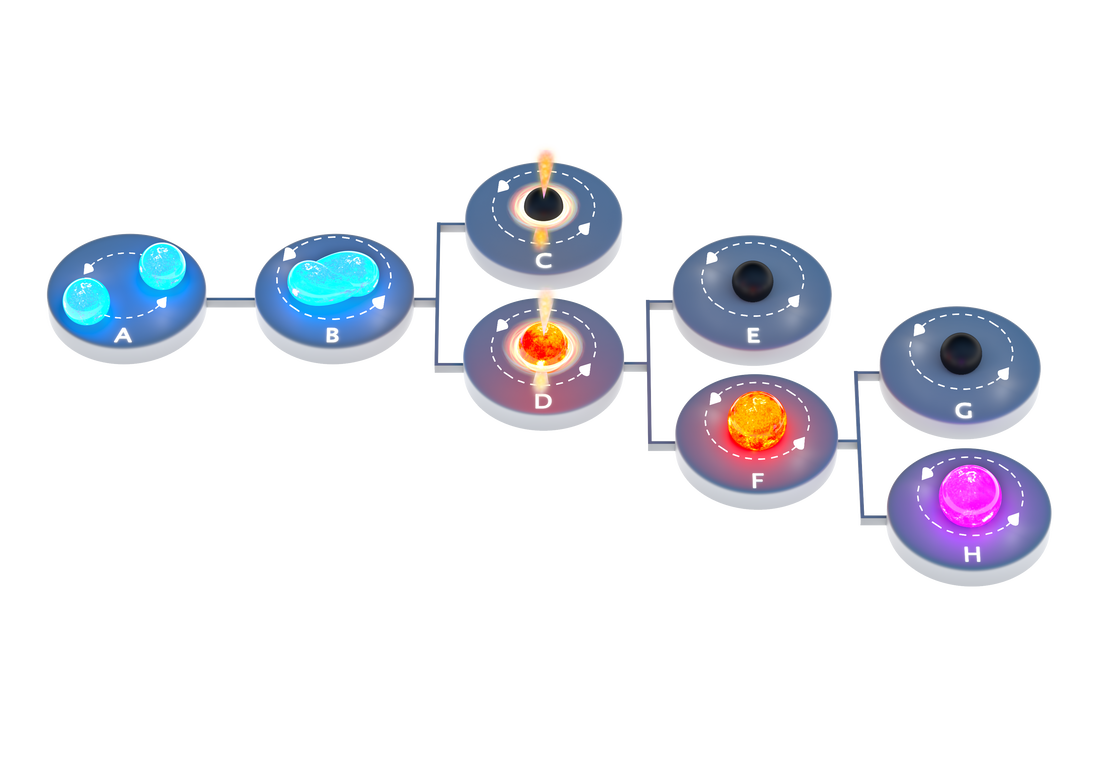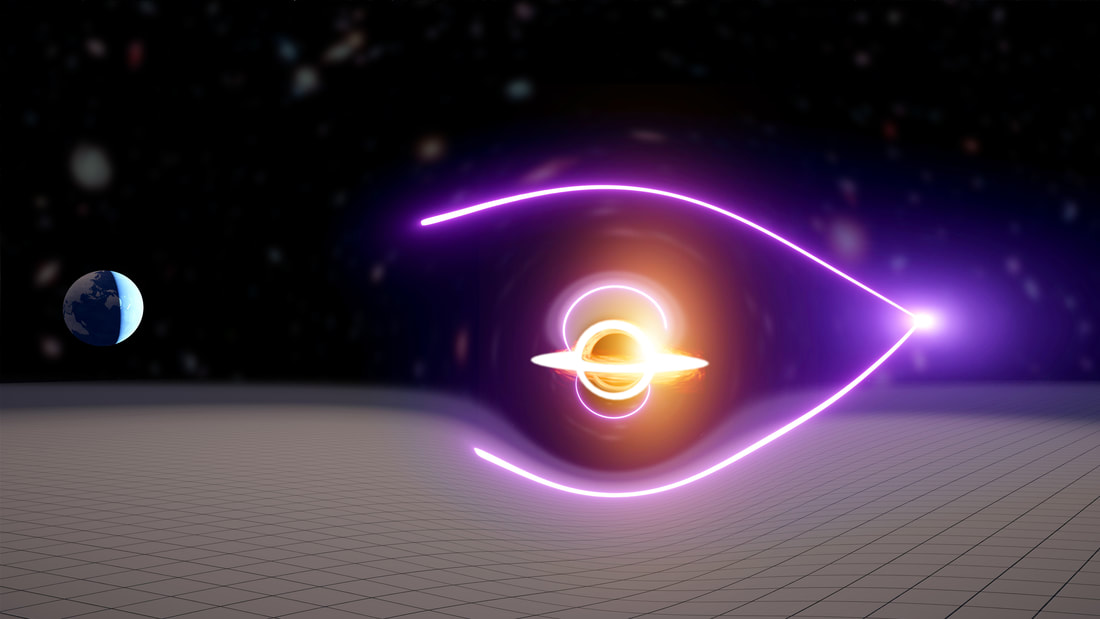|
Our Universe shines bright with light across the electromagnetic spectrum. While most of this light comes from stars like our Sun in galaxies like our own, we are often treated with brief and bright flashes that outshine entire galaxies themselves. Some of these brightest flashes are believed to be produced in cataclysmic events, such as the death of massive stars or the collision of two stellar corpses known as neutron stars. Researchers have long studied these bright flashes or ‘transients’ to gain insight into the deaths and afterlives of stars and the evolution of our Universe. Astronomers are sometimes greeted with transients that defy expectations and puzzle theorists who have long predicted how various transients should look. In October 2014, a long-term monitoring programme of the southern sky with the Chandra telescope—NASA’s flagship X-Ray telescope—detected one such enigmatic transient called CDF-S XT1: a bright transient lasting a few thousands of seconds. The amount of energy CDF-S XT1 released in X-rays was comparable to the amount of energy the Sun emits over a billion years. Ever since the original discovery, astrophysicists have come up with many hypotheses to explain this transient; however, none have been conclusive. In a recent study, a team of astrophysicists led by OzGrav postdoctoral fellow Dr Nikhil Sarin (Monash University) found that the observations of CDF-S XT1 match predictions of radiation expected from a a high-speed jet travelling close to the speed of light. Such “outflows” can only be produced in extreme astrophysical conditions, such as the disruption of a star as it gets torn apart by a massive black hole, the collapse of a massive star, or the collision of two neutron stars. Sarin et al’s study found that the outflow from CDF-S XT1 was likely produced by two neutron stars merging together. This insight makes CDF-S XT1 similar to the momentous 2017 discovery called GW170817—the first observation of gravitational-waves, cosmic ripples in the fabric of space and time—although CDF-S XT1 is 450 times further away from Earth. This huge distance means that this merger happened very early in the history of the Universe; it may also be one of the furthest neutron star mergers ever observed. Neutron star collisions are the main places in the Universe where heavy elements such as gold, silver, and plutonium are created. Since CDF-S XT1 occurred early on in the history of the Universe, this discovery advances our understanding of Earth’s chemical abundance and elements. Recent observations of another transient AT2020blt in January 2020—primarily with the Zwicky Transient Facility—have puzzled astronomers. This transient’s light is like the radiation from high-speed outflows launched during the collapse of a massive star. Such outflows typically produce higher energy gamma-rays; however, they were missing from the data – they were not observed. These gamma rays can only be missing due to one of three possible reasons: 1) The gamma-rays were not produced. 2) The gamma rays were directed away from Earth. 3) The gamma-rays were too weak to be seen. In a separate study, led again by OzGrav researcher Dr Sarin, the Monash University astrophysicists teamed up with researchers in Alabama, Louisiana, Portsmouth and Leicester to show that AT2020blt probably did produce gamma-rays pointed towards Earth, they were just really weak and missed by our current instruments. Dr Sarin says: “Together with other similar transient observations, this interpretation means that we are now starting to understand the enigmatic problem of how gamma-rays are produced in cataclysmic explosions throughout the Universe”. The class of bright transients collectively known as gamma-ray bursts, including CDF-S XT1, AT2020blt, and AT2021any, produce enough energy to outshine entire galaxies in just one second. “Despite this, the precise mechanism that produces the high-energy radiation we detect from the other side of the Universe is not known,” explains Dr Sarin. “These two studies have explored some of the most extreme gamma-ray bursts ever detected. With further research, we’ll finally be able to answer the question we’ve pondered for decades: How do gamma ray bursts work?”
0 Comments
 Schematic representation of binary neutron star merger outcomes. Panels A and B: Two neutron stars merge as the emission of gravitational waves drives them towards one another. C: If the remnant mass is above a certain mass, it immediately forms a black hole. D: Alternatively, it forms a quasistable ‘hypermassive’ neutron star. E: As the hypermassive star spins down and cools it can not support itself against gravitational collapse and collapses into a black hole. F, G: If the remnant’s mass is sufficiently low, it will survive for longer, as a ‘supramassive’ neutron star, supported against collapse through additional support against gravity through rotation, collapsing into a black hole once it loses this support. H: If the remnant is born with small enough mass, it will survive indefinitely as a neutron star. Schematic from Sarin & Lasky 2021. Image credit: Carl Knox (Swinburne University). On 17th August 2017, LIGO detected gravitational waves from the merger of two neutron stars. This merger radiated energy across the electromagnetic spectrum, light that we can still observe today. Neutron stars are incredibly dense objects with masses larger than our Sun confined to the size of a small city. These extreme conditions make some consider neutron stars the caviar of astrophysical objects, enabling researchers to study gravity and matter in conditions unlike any other in the Universe. The momentous 2017 discovery connected several pieces of the puzzle on what happens during and after the merger. However, one piece remains elusive: What remains behind after the merger? In a recent article published in General Relativity and Gravitation, Nikhil Sarin and Paul Lasky, two OzGrav researchers from Monash University, review our understanding of the aftermath of binary neutron star mergers. In particular, they examine the different outcomes and their observational signatures. The fate of a remnant is dictated by the mass of the two merging neutron stars and the maximum mass a neutron star can support before it collapses to form a black hole. This mass threshold is currently unknown and depends on how nuclear matter behaves in these extreme conditions. If the remnant's mass is smaller than this mass threshold, then the remnant is a neutron star that will live indefinitely, producing electromagnetic and gravitational-wave radiation. However, if the remnant is more massive than the maximum mass threshold, there are two possibilities: if the remnant mass is up to 20% more than the maximum mass threshold, it survives as a neutron star for hundreds to thousands of seconds before collapsing into a black hole. Heavier remnants will survive less than a second before collapsing to form black holes. Observations of other neutron stars in our Galaxy and several constraints on the behaviour of nuclear matter suggest that the maximum mass threshold for a neutron star to avoid collapsing into a black hole is likely around 2.3 times the mass of our Sun. If correct, this threshold implies that many binary neutron star mergers go on to form more massive neutron star remnants which survive for at least some time. Understanding how these objects behave and evolve will provide a myriad of insights into the behaviour of nuclear matter and the afterlives of stars more massive than our Sun. Written by PhD student Nikhil Sarin, University of Adelaide  Illustration of binary neutron stars - Carl Knox, OzGrav-Swinburne University Illustration of binary neutron stars - Carl Knox, OzGrav-Swinburne University Binary neutron stars have been detected in the Milky Way as millisecond pulsars and twice outside the galaxy via gravitational-wave emission. Most of them have orbital periods of less than a day—a contrasting difference to their progenitors: massive stellar binaries that have hundreds or thousands of days orbital periods. In the last several decades, there has been much debate about explaining how massive binaries transition to double compact objects. To date, one of the strong contenders to explain this transition is the highly-complex stage of binary stellar evolution known as the common-envelope phase. The common-envelope phase is a particular outcome of a mass transfer episode. It begins with the Roche-lobe overflow of (at least) one of the stars, and it’s prompted by a dynamical instability. In a simple version, the stellar envelope of the mass-transferring star—the donor—bloats and engulfs the whole binary, creating a new system comprised of an inner compact binary, and a shared “common” envelope. The interaction of the inner binary with the common envelope results in drag, and the dissipated gravitational energy is transferred onto the common envelope, which can lead to its ejection. A successful ejection suggests that a compact binary can form. But what does a “successful ejection” mean? To explore the common-envelope phase with three-dimensional hydrodynamical models, we attempted to address the likely outcomes of common-envelope evolution by considering the response of a one-dimensional stellar model to envelope removal. In a recent study, we focussed on the common-envelope phase scenario of a donor star with a neutron star companion. We emulated the common-envelope phase by removing the envelope of the donor star, either partially or completely. After the star was stripped, we followed its radial evolution. The most extreme scenarios resulted as expected: If you remove all the envelope, the stripped star remains compact. Alternatively, if you leave most of the envelope, the stripped star subsequently expands a lot. The question is: what happens in between the extreme cases? Our research shows that when most of the envelope, but not all of it, is removed, the star experiences a short phase of marginal contraction (<100 years), but overall, the star remains compact during the next 1000 years. This suggests that a star doesn’t needs to be stripped all the way to the core to avoid an imminent stellar merger. Moreover, the amount of energy needed to partially strip the envelope is less than the one needed to fully remove it. Finally, it’s reassuring that our results show a strong correlation to variations in donor mass and composition. This research is a step forward in the understanding of the common envelope phase and the formation of double neutron star binaries. Our results imply that a star can be stripped without experiencing Roche lobe overflow immediately after the common envelope, a likely condition for a successful envelope ejection. It also suggests that stripped stars retain a few solar masses of peculiar, hydrogen-poor material in their surface. While this amount of hydrogen is not excessive, it might be observable in the spectra of a star and can play a role at the end of its life when it explodes into a supernova. While the full understanding of the common-envelope phase remains elusive, we are connecting the dots of the evolution and fate of systems that have experienced a common-envelope event. Written by OzGrav research Alejandro Vigna-Gómez from the Niels Bohr Institute (University of Copenhagen) |
|
- Home
- About
-
Our People
- Chief Investigators
- Partner Investigators
- Associate Investigators
- Postdocs and Students >
- Professional & Outreach staff
- Governance Advisory Committee
- Scientific Advisory Committee
- Executive Committee
- Equity & Diversity Committee
- Early Career Researcher Committee
- Professional Development Committee
- Research Translation Committee
- OzGrav Alumni
- Research Themes
- Education and Outreach
- Events
- News/Media
- Contact Us
- Home
- About
-
Our People
- Chief Investigators
- Partner Investigators
- Associate Investigators
- Postdocs and Students >
- Professional & Outreach staff
- Governance Advisory Committee
- Scientific Advisory Committee
- Executive Committee
- Equity & Diversity Committee
- Early Career Researcher Committee
- Professional Development Committee
- Research Translation Committee
- OzGrav Alumni
- Research Themes
- Education and Outreach
- Events
- News/Media
- Contact Us


 RSS Feed
RSS Feed








